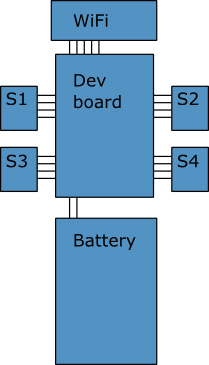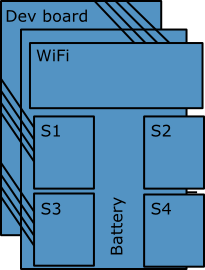Previous posts:
Sudden Impact Design Challenge - Modular/Configurable System Intro
Hardware Components
My plan is to make a modular and easy to configure prototype. It will also have to be accurate and should provide realtime sensor data.
In my initial post I explained my plan only in rough words. I will now try to be more elaborated about the hardware components.
1) Remote units
a) MCU and wireless connection
Remote units will be based on a small development module.
Until I receive my kit I will not make the final decision regarding the development board that I will use. ADuCM350 might be sufficient since it provides a powerful processor and plenty of GPIO pins but if that turns out to be a problem for whatever reason (it’s probably too big), I will select Arduino Pro Mini as it features small size and a lot of IO pins I can use. It’s based on a well-known MCU. It does not include USB to Serial converter, which is also a plus (decreases both size and unit price). Prototyping is easy using Arduino IDE.
For communication with central unit, cheap ESP8266 breakout board (ESP-03 variant) will be used. This is a Wi-Fi module made by Espressif. I selected a variant with no headers to make the smaller device and a ceramic antenna to make better transmission range. Some range tests were performed for this module and here's the result of one of them: https://www.youtube.com/watch?v=7BYdZ_24yg0#t=385. This should be good enough for almost any kind of sport field - for additional range, additional repeater access points could be setup in the field.
Remote units will be equipped with sensor modules connected using wires. If I get to the point that I need to communicate with some sensor wirelessly, BLE connection will be used. Connected sensors will be enumerated at startup and list of them will be published to central unit.
Figure 1. Remote unit
b) Sensors
I will use accelerometers, temperature sensors and heart rate monitor sensors.
My plan is to make them easy to attach/detach to/from the remote unit (using connectors). If time allows, I will also include an ECG module.
c) Power Supply
LiFePo4 batteries will power the remote units (like this one: http://www.batteryspace.com/lifepo4-18650-battery-3-2v-1250mah-4a-rate-4-wh-rechargeable-battery.aspx). Batteries will be removable for charging. Final selection for batteries will be made after I make the power consumption estimate (didn’t consider that at this time).
d) Form Factor
Remote unit shape should also be configurable to some extent. The idea is to make the same device suitable for many sport disciplines. I plan to make the remote unit foldable so it can be made long and thin or short and thick (when folded):
Figure 1. Folded remote unit
2) Central unit
Central unit will be in charge of data collection. Remote units will talk to the central unit via Wi-Fi connection. This unit will run a MQTT broker to receive data from remote units. Sensor data will be dispatched to all subscribed clients (coach’s or assistants' phones and tablets). Sensor data will also be stored in the database too so it can be reviewed later.
BeagleBone Black or Raspberry Pi will serve as a central unit. Both of them should have more than enough computing power for this task.
3) Monitoring units
Almost any mobile phone or tablet device will be able to serve as a monitoring device. These devices will be equipped with an application that will enable them to display real-time sensor data in a convenient manner. They will also provide instant alerts when some alert criteria are met. If time allows, alert criteria will be configurable by each monitor user.
I will probably use Qt framework to develop a cross-platform application, since I’m already working on a similar application.
In my next post I will go into more details about software part of this project. Communication flow will also be explained.
Greetings,
Dragan



Top Comments
-

DAB
-
Cancel
-
Vote Up
+2
Vote Down
-
-
Sign in to reply
-
More
-
Cancel
Comment-

DAB
-
Cancel
-
Vote Up
+2
Vote Down
-
-
Sign in to reply
-
More
-
Cancel
Children